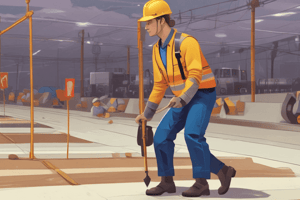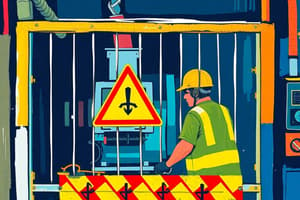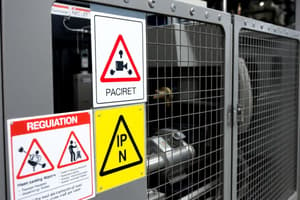Podcast
Questions and Answers
What must a person making a thorough examination notify the employer about?
What must a person making a thorough examination notify the employer about?
Any defect in the lifting equipment which could become a danger to persons
What should a report of thorough examination include?
What should a report of thorough examination include?
Details of any tests carried out and specified information in schedule 1.
An employer must ensure that lifting equipment is used before any defects are rectified if notified of an imminent risk.
An employer must ensure that lifting equipment is used before any defects are rectified if notified of an imminent risk.
False (B)
Which of the following is NOT a requirement for lifting accessories post-examination?
Which of the following is NOT a requirement for lifting accessories post-examination?
What is the purpose of the Manual Handling Operations Regulations 1992?
What is the purpose of the Manual Handling Operations Regulations 1992?
Which of these is a primary duty of employees under the Electricity at Work Regulations?
Which of these is a primary duty of employees under the Electricity at Work Regulations?
The Electromagnetic Compatibility Directive aims to prevent interference with electrical equipment.
The Electromagnetic Compatibility Directive aims to prevent interference with electrical equipment.
What is one of the recommendations for working at height?
What is one of the recommendations for working at height?
What is the main purpose of the Lifting Operations and Lifting Equipment Regulations (LOLER)?
What is the main purpose of the Lifting Operations and Lifting Equipment Regulations (LOLER)?
Reports of thorough examination must be made in writing and authenticated by the __________.
Reports of thorough examination must be made in writing and authenticated by the __________.
What is the primary responsibility of employers regarding health and safety?
What is the primary responsibility of employers regarding health and safety?
Match the standards to their categories:
Match the standards to their categories:
What are the main purposes of the Health and Safety at Work Act?
What are the main purposes of the Health and Safety at Work Act?
The Health and Safety at Work Act only applies to certain sectors.
The Health and Safety at Work Act only applies to certain sectors.
Which of the following are duties of the employer under the Health and Safety at Work Act?
Which of the following are duties of the employer under the Health and Safety at Work Act?
What does the term 'Competent Person' refer to in the context of health and safety legislation?
What does the term 'Competent Person' refer to in the context of health and safety legislation?
What are the three main reasons to assess and manage risk?
What are the three main reasons to assess and manage risk?
A hazard is something that has the potential to cause _____ .
A hazard is something that has the potential to cause _____ .
What are the five steps to risk assessment?
What are the five steps to risk assessment?
What is a 'Machine' as defined by the European Machinery Directive?
What is a 'Machine' as defined by the European Machinery Directive?
The Supply of Machinery (Safety) Regulations 2008 implement the Machinery Directive in the UK.
The Supply of Machinery (Safety) Regulations 2008 implement the Machinery Directive in the UK.
What is the duty of manufacturers, importers, and suppliers regarding equipment safety?
What is the duty of manufacturers, importers, and suppliers regarding equipment safety?
What must be included in the Technical File?
What must be included in the Technical File?
What does the CE mark signify?
What does the CE mark signify?
Lifting equipment must sustain a static overload of 1.5 x WLL for manually operated machines.
Lifting equipment must sustain a static overload of 1.5 x WLL for manually operated machines.
Which regulations apply to all work equipment?
Which regulations apply to all work equipment?
What is the minimum inspection period for lifting equipment under LOLER?
What is the minimum inspection period for lifting equipment under LOLER?
PUWER requires employers to ensure that __________ meets essential health and safety requirements.
PUWER requires employers to ensure that __________ meets essential health and safety requirements.
What should employers do to ensure compliance with PUWER?
What should employers do to ensure compliance with PUWER?
Match the following LOLE regulations with their focus:
Match the following LOLE regulations with their focus:
What must be checked before lifting equipment is put into service?
What must be checked before lifting equipment is put into service?
What is an undesirable characteristic of six strand ropes when load is applied?
What is an undesirable characteristic of six strand ropes when load is applied?
What type of rope can overcome the untwisting issue associated with six strand ropes?
What type of rope can overcome the untwisting issue associated with six strand ropes?
What is the construction type of the most common low-rotating rope?
What is the construction type of the most common low-rotating rope?
What does BS EN 12385 use to denote uncoated or bright finish?
What does BS EN 12385 use to denote uncoated or bright finish?
What is the maximum wear percentage for rotation-resistant rope that indicates discard?
What is the maximum wear percentage for rotation-resistant rope that indicates discard?
What is an essential factor that can lead to the discard of wire ropes?
What is an essential factor that can lead to the discard of wire ropes?
In the case of 6 and 8-strand ropes, broken wires usually occur at the ______.
In the case of 6 and 8-strand ropes, broken wires usually occur at the ______.
What type of damage leads to immediate discard of wire ropes?
What type of damage leads to immediate discard of wire ropes?
What is the recommended method for keeping wire ropes in good condition?
What is the recommended method for keeping wire ropes in good condition?
What type of hoist uses Type T manually operated chains?
What type of hoist uses Type T manually operated chains?
Which chain type is used in abrasive conditions?
Which chain type is used in abrasive conditions?
Case hardened chains are suitable for portable manually operated hoists.
Case hardened chains are suitable for portable manually operated hoists.
What must be observed to prevent premature failure of the chain?
What must be observed to prevent premature failure of the chain?
How often should chains be inspected under very heavy service conditions?
How often should chains be inspected under very heavy service conditions?
A few links of load chain is sufficient to ensure the chain is under _______.
A few links of load chain is sufficient to ensure the chain is under _______.
The chain should always be covered in dirt or debris.
The chain should always be covered in dirt or debris.
What lubrication is recommended for adverse working conditions?
What lubrication is recommended for adverse working conditions?
What should be checked to determine if a chain needs to be replaced?
What should be checked to determine if a chain needs to be replaced?
Load chains should never be back hooked or _______.
Load chains should never be back hooked or _______.
What is a common misunderstanding regarding load chain stretch?
What is a common misunderstanding regarding load chain stretch?
What percentage rating towards discard indicates the presence of 40% broken wires?
What percentage rating towards discard indicates the presence of 40% broken wires?
What is one method of forming eyes in hoist wire ropes?
What is one method of forming eyes in hoist wire ropes?
Which splice is recommended for securing the end of a rope?
Which splice is recommended for securing the end of a rope?
Wire rope grips are suitable for lifting applications.
Wire rope grips are suitable for lifting applications.
What standard refers to the asymmetrical wedge socket for load ropes?
What standard refers to the asymmetrical wedge socket for load ropes?
The fastening elements for the rope should resist _____ times the static rope force.
The fastening elements for the rope should resist _____ times the static rope force.
What does BS EN 1993 (Part 6) relate to?
What does BS EN 1993 (Part 6) relate to?
Match the following methods of securing eyes with their descriptions:
Match the following methods of securing eyes with their descriptions:
Flashcards are hidden until you start studying
Study Notes
LEEA Training Framework
- LEEA Academy provides the Overhead Travelling Cranes Advanced Programme to ensure comprehensive training.
- Students must adhere to health and safety guidelines, maintain cleanliness, and respect training protocols.
Employer and Employee Responsibilities
- Employers are legally required to provide safe working conditions and systems.
- Employees must cooperate and avoid actions that jeopardize health and safety.
Health and Safety Legislation
- Health and Safety at Work Act 1974 is a primary regulation, applicable across all sectors in the UK.
- It aims to secure safety for employees, protect the public from workplace hazards, and regulate dangerous substances.
Core Elements of the Health and Safety Act
- Employers ensure safe operations and adequate training for staff.
- Specific duties outlined for manufacturers, importers, and suppliers to certify equipment safety.
Risk Assessment Process
- Risk assessment evaluates potential workplace hazards, their likelihood, and consequences.
- Principal reasons for assessing risks include ensuring human safety, abiding by legal duties, and mitigating financial costs.
Definitions in Risk Assessment
- Hazard: Potential source of harm.
- Danger: Exposure to harm.
- Risk: Combination of likelihood and severity of potential harm.
Risk Assessment Steps
- Identify hazards, evaluate who might be harmed, and implement control measures.
- Control measures follow a hierarchy: Eliminate, Reduce, Isolate, Control, PPE, Discipline.
Safe System of Work
- A comprehensive system involves identifying hazards, assessing risks, and regularly reviewing procedures.
European Machinery Directive
- Aims to harmonize health and safety requirements across EU member states for machinery safety.
- Defines "Machine" as an assembly with interconnected components that includes a drive system.
Supply of Machinery (Safety) Regulations 2008
- UK implementation of the Machinery Directive mandates safety tests and maintenance of technical records by manufacturers.
- Certificates like the Declaration of Conformity and CE marking are required to signify safety compliance.
Competent Person Definition
- A ‘Competent Person’ must possess knowledge and experience to identify equipment defects.
- Responsibility for safety is a collaborative effort between employer and employee.
Overview of Regulations
- Numerous regulations are derived from HSWA, including the Manual Handling Operations Regulations and the Control of Substances Hazardous to Health Regulations.
- Regulations support health and safety compliance but are not acts of Parliament.
Competency in the Workplace
- LEEA emphasizes that competency involves ongoing information, instruction, training, and supervision.
- Competency ensures safe practices in the handling and operation of lifting equipment.### The Technical File and Health & Safety Requirements
- Essential Health and Safety Requirements for lifting equipment include methods to eliminate hazards, standards used in design, design documentation, and material traceability.
- Lifting equipment must comply with the Machinery Directive, ensuring it can sustain specific overloads:
- Manually operated machines: 1.5 times Working Load Limit (WLL)
- Other machines: 1.25 times WLL
- Lifting accessories: 1.5 times WLL
- Equipment must also endure a dynamic overload of 1.1 times WLL.
- Instructions must be provided for safe care, installation, maintenance, and training.
Regulations Overview
- Provision and Use of Work Equipment Regulations 1998 (PUWER) applies to all work equipment.
- Lifting Operations and Lifting Equipment Regulations 1998 (LOLER) add requirements for lifting equipment, complementing PUWER.
- Both regulations are legal requirements in the UK and are seen as best practices internationally.
Key Essentials of PUWER
- Employers must ensure work equipment meets Essential Health and Safety Requirements (EHSRs) and is suitable for intended use.
- Regular inspections and maintenance logs are mandatory.
- Clear information must be provided to users, including safe operation manuals.
- Compliance with PUWER applies to equipment from all manufacturing dates, particularly emphasizing equipment used after December 31, 1992.
- Risks may arise due to differing applications, installation issues, or mismatches in legislation.
Checks for Compliance
- Employers should look for CE marking and the EC declaration of conformity to ensure compliance with PUWER.
Key Regulations under LOLER
- Regulation 4 mandates the strength and stability of lifting equipment for safe operation.
- Regulation 5 outlines additional requirements when lifting persons.
- Regulation 9 stipulates thorough examination before equipment use, with maximum inspection intervals:
- Lifting Accessories: every 6 months
- General Lifting Equipment: every 12 months
- People Carrying Equipment: every 6 months
Reports of Thorough Examination
- Reports must include details such as employer information, safe working load, and identified defects.
- Competent persons must promptly report any defects posing imminent dangers to the employer and relevant authorities.
Written Schemes of Examination
- A written scheme should be created by a competent person, detailing scope, intervals, and procedures for thorough examinations of safety-critical components.
- The scheme should assess equipment conditions, usage, and operational changes to adjust thorough examination frequency as necessary.
Manual Handling Operations Regulations 1992
- Regulations address manual load handling risks, encouraging assessments of tasks, loads, and environments to mitigate injuries.
- Introduces lifting appliances for high-risk tasks or those that could be made safer through mechanical assistance.
Working at Height
- Work at height poses significant risk of falls, requiring proper risk assessment and precautions to minimize accidents.
- Regulations emphasize avoiding work at height when practicable, using safe equipment for necessary tasks, and minimizing fall distance.
- Working at Height Regulations 2005 stress the importance of controlling risks and employing suitable means to ensure safety during lifting practices. ### Working at Height Safety Guidelines
- Prioritize working from the ground whenever possible.
- Ensure safe access and egress for workers at height.
- Use equipment that is sturdy, well-maintained, and suitable for the task.
- Implement precautions for working near fragile surfaces.
- Provide safeguards against falling objects.
- Establish and plan for emergency evacuation and rescue scenarios.
Restrictions for Working at Height
- Avoid overloading ladders and ensure compliance with weight limits.
- Do not overreach on ladders or stepladders.
- Ladders should not be placed against weak surfaces (e.g., plastic gutters).
- Use ladders only for light tasks, limited to a maximum of 30 minutes.
- Restrict work at height to trained and competent personnel.
Electricity at Work Regulations
- Applicable to all workplaces, imposing duties to minimize electrical risks.
- Responsibilities extend to both employers and employees.
- Employees must cooperate with employers and ensure compliance with safety duties.
- Electrical equipment includes all devices intended for generating or using electrical energy.
Electromagnetic Compatibility Directive
- Aims to harmonize technical rules for health and safety of new products in the EU.
- The Electromagnetic Compatibility Directive (2004/108/EC) prevents interference between electrical equipment.
- Regulations ensure both reduced electromagnetic disturbance and immunity of electrical equipment.
Lifting Equipment Legislation
- The Factories Act 1961 was the primary law for lifting equipment until updated regulations were enacted.
- The Provision and Use of Work Equipment Regulations 1998 and Lifting Operations and Lifting Equipment Regulations 1998 replaced previous legislation.
- New regulations address safety standards for lifting equipment usage and examination.
Standards for Overhead Travelling Cranes
- Divided into five categories: Design, Classification, Gantries, Thorough Examination, and Other Relevant Standards.
- Standards guide safe practices and specifications, such as BS EN 13001 for crane design.
Types of Standards
- Manufacturing standards focus on dimensions and load capacities.
- Performance standards outline criteria the final product must meet.
- ISO standards, although optional, are often the baseline for national standards.
Load Chains and Specifications
- Fine tolerance hoist chains are detailed in BS EN 818-7.
- Types include Grades T, DAT, and DT, intended for various lifting conditions.
- Load chains must resist wear, corrosion, and maintain strength.
Chain Inspection and Maintenance
- Conduct frequent inspections based on service levels: light, moderate, heavy, and very heavy.
- Periodic inspections require more comprehensive evaluations and records.
- Thorough examinations must be performed by a Competent Person, often requiring disassembly.
Stretch versus Elongation in Chains
- Stretch indicates exceeding the elastic limit; such chains should be withdrawn from use.
- Elongation refers to normal wear from chain movement during use.
Chain Guidelines
- Maintain proper alignment and tension for load engagement.
- Ensure load chains are clean, free from debris, and properly lubricated.
- Chains should hang straight; avoid twisting and back hooking.
- Inspect for wear, distortion, and damage, and comply with manufacturer specifications for safety.
Studying That Suits You
Use AI to generate personalized quizzes and flashcards to suit your learning preferences.




